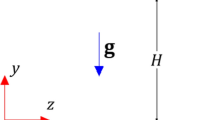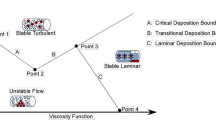Abstract
This study aims at understanding the influence of the various physical mechanisms involved in the transport of solid particles within slurry flows. The present model simulates such mixtures as pseudo-single-phase fluids. The approach is based on a constitutive equation, which accounts for the shear-induced particle migration. Two supplementary terms are added to this equation to account for particle buoyancy and turbulent dispersion, respectively. The present model is validated against experimental data published in the literature, and the influence of each mechanism is discussed in detail for two particle diameters \(d=125\) and \(440 \, \upmu \mathrm{m}\) and bulk Reynolds numbers \(\mathrm{Re}\) ranging between 46,000 and 109,000. The detailed budget analysis of the present transport equation reveals that the terms accounting for the particle transport due to the viscosity variation and the particle collision frequency variation get preponderant in the near-wall regions. This last term is besides at the origin of the repelling phenomenon. The turbulent agitation term counterbalances the sedimentation effect. When the convective flux term is important in the bulk region, the flow tends to be homogeneous. The present model can be used confidently to model two-phase flows under certain multiphase flow regimes while requiring less computational efforts than other more complex two-phase models.









Similar content being viewed by others
Abbreviations
- a :
-
Particle radius (m)
- d :
-
Particle diameter (m)
- D :
-
Pipe diameter (m)
- f :
-
Dumping function (–)
- g :
-
Gravity acceleration (\(\mathrm{m\,s}^{-2}\))
- k :
-
Turbulence kinetic energy (\(\mathrm{m}^2\,\mathrm{s}^{-2}\))
- \(K_{c}\), \(K_{\mu }\) :
-
Constants (–)
- L :
-
Pipe length (m)
- p :
-
Pressure (Pa)
- Re:
-
Reynolds number (\(=\rho _\mathrm{m} U_\mathrm{m} D / \mu _\mathrm{m}\)) (–)
- \(T_\mathrm{L}\) :
-
Lagrangian integral time scale (s)
- \(U_\mathrm{m}\) :
-
Inlet mean flow velocity (\(\mathrm{m}\,\mathrm{s}^{-1}\))
- \(u_i\) :
-
Local mean velocity in the i-th direction (\(\mathrm{m}\,\mathrm{s}^{-1}\))
- (x, y, z):
-
Cartesian coordinates (m)
- \(x_i\) :
-
Coordinate in the i-th direction
- \(\delta \) :
-
Kronecker symbol (–)
- \(\varepsilon \) :
-
Dissipation rate of the turbulence kinetic energy (\(\mathrm{m}^2\,\mathrm{s}^{-3}\))
- \({\varGamma }_\mathrm{T}\) :
-
Particle turbulent diffusion (\(\mathrm{m}^2\,\mathrm{s}^{-1}\))
- \({\dot{\gamma }}\) :
-
Shear rate magnitude (\(\mathrm{s}^{-1}\))
- \(\mu \) :
-
Dynamic viscosity (Pa s)
- \(\mu _\mathrm{r}\) :
-
Relative dynamic viscosity (i.e. \(\mu _\mathrm{m}/\mu _\mathrm{l}\)) (–)
- \(\nu \) :
-
Kinematic viscosity (\(\mathrm{m}^2\,\mathrm{s}^{-1}\))
- \(\rho \) :
-
Density (\(\mathrm{kg}\,\mathrm{m}^{-3}\))
- \(\phi \) :
-
Local particle volume fraction (\(\mathrm{m}^{+3}\,\mathrm{m}^{-3}\))
- \({\varPhi }_{\mathrm{m}}\) :
-
Inlet mean particle volume fraction (\(\mathrm{m}^{+3}\,\mathrm{m}^{-3}\))
- \(\phi _{\mathrm{max}}\) :
-
Maximum packing particle volume fraction (\(\mathrm{m}^{+3}\,\mathrm{m}^{-3}\))
- \(\omega \) :
-
Specific turbulence dissipation rate (\(\mathrm{s}^{-1}\))
- \(\omega _{s0}\) :
-
Initial particle settling velocity (\(\mathrm{m}\,\mathrm{s}^{-1}\))
- \(\tau _{ij}\) :
-
Shear stress tensor components (Pa)
- i, j :
-
Indexes
- l:
-
Liquid phase, aqueous solution
- m:
-
Mean or mixture
- max:
-
Maximum value
- s:
-
Solid phase, particles
References
M. Kauffeld, M. Kawaji, P.W. Egolf, Handbook on Ice Slurries: Fundamentals and Engineering (International Institute of Refrigeration, Paris, 2005)
A. Bordet, S. Poncet, M. Poirier, N. Galanis, Flow visualizations and pressure drop measurements of isothermal ice slurry pipe flows. Exp. Therm. Fluid Sci. 99, 595–604 (2018)
C.T. Crowe, On models for turbulence modulation in fluid-particle flows. Int. J. Multiphase Flow 26, 719–727 (2000)
J.P. Matas, J.F. Morris, E. Guazzelli, Transition to turbulence in particulate pipe flow. Phys. Rev. Lett. 90, 014501 (2003)
S. Ghosh, F. Mugele, M. Duits, Effects of shear and walls on the diffusion of colloids in microchannels. Phys. Rev. E 91, 052305 (2015)
W.T. Wu, N. Aubry, J.F. Antaki, M. Massoudi, Flow of a fluid-solid mixture: normal stress differences and slip boundary condition. Int. J. Non-Linear Mech. 90, 39–49 (2017)
S. Balachandar, J.K. Eaton, Turbulent dispersed multiphase flow. Annu. Rev. Fluid Mech. 42(1), 111–133 (2010)
S. Balachandar, A scaling analysis for point-particle approaches to turbulent multiphase flows. Int. J. Multiphase Flow 35(9), 801–810 (2009)
R.J. Phillips, R.C. Armstrong, R.A. Brown, A.L. Graham, J.R. Abbott, A constitutive equation for concentrated suspensions that accounts for shear-induced particle migration. Phys. Fluids A 4(1), 30–40 (1992)
P.R. Nott, J.F. Brady, Pressure-driven flow of suspensions: simulation and theory. J. Fluid Mech. 275, 157–199 (1994)
C.J. Koh, P. Hookham, L.G. Leal, An experimental investigation of concentrated suspension flows in a rectangular channel. J. Fluid Mech. 266, 1–32 (1994)
K. Zhang, A. Acrivos, Viscous resuspension in fully developed laminar pipe flows. Int. J. Multiphase Flow 20(3), 579–591 (1994)
R.E. Hampton, A.A. Mammoli, A.L. Graham, N. Tetlow, S.A. Altobelli, Migration of particles undergoing pressure-driven flow in a circular conduit. J. Rheol. 41(3), 621–640 (1997)
M. Korhonen, M. Mohtaschemi, A. Puisto, X. Illa, M. Alava, Apparent wall slip in non-Brownian hard-sphere suspensions. Eur. Phys. J. E 38(46), 1–9 (2015)
R.B. Reboucas, I.R. Siqueira, P.R. de Souza Mendes, M.S. Carvalho, On the pressure-driven flow of suspensions: particle migration in shear sensitive liquids. J. Non-Newtonian Fluid Mech. 234, 178–187 (2016)
I.M. Krieger, T.J. Dougherty, A mechanism for non-Newtonian flow in suspensions of rigid spheres. J. Rheol. 3, 137–152 (1959)
J. Morris, F. Boulay, Curvilinear flows of noncolloidal suspensions: the role of normal stresses. J. Rheol. 43, 1213–1237 (1999)
T. Xiong, Z. Xinzhuo, S.A. Miedema, X. Chen, Study of the characteristics of the flow regimes and dynamics of coarse particles in pipeline transportation. Powder Technol. 347, 148–158 (2019)
M. Maxey, Simulation methods for particulate flows and concentrated suspensions. Annu. Rev. Fluid Mech. 49, 171–193 (2017)
S.A. Miedema, Slurry Transport: Fundamentals, Historical Overview & DHLLDV (TU Delft Open, 2018)
A. Bordet, S. Poncet, M. Poirier, N. Galanis, Numerical simulation of isothermal ice slurry flows through horizontal pipes, in Proceedings of the CSME International Congress (Kelowna, Canada, 2016)
A. Bordet, S. Poncet, M. Poirier, N. Galanis, Validation d’un modèle original pour l’hydrodynamique des coulis de glace à partir d’écoulements de suspensions particulaires. in XIIIème Colloque Interuniversitaire Franco-Québécois sur la Thermique des Systèmes (Saint-Lô, France, 2017)
A. Bordet, Experiments and numerical modelling of isothermal ice slurry flows. Ph.D. thesis, Université de Sherbrooke (2018)
D.R. Kaushal, K. Sato, T. Toyota, K. Funatsu, Y. Tomita, Effect of particle size distribution on pressure drop and concentration profile in pipeline flow of highly concentrated slurry. Int. J. Multiphase Flow 31(7), 809–823 (2005)
H.J.H. Brouwers, Viscosity of a concentrated suspension of rigid monosized particles. Phys. Rev. E 81(5), 051402-1–051402-11 (2010)
F.R. Menter, Two-equation eddy-viscosity turbulence models for engineering applications. AIAA J. 32(8), 1598–1605 (1994)
S.B. Pope, Turbulent Flows (Cambridge University Press, Cambridge, 2000)
R. Blazejewski, Apparent viscosity and settling velocity of suspensions of rigid monosized spheres in Stokes flow. Int. J. Multiphase Flow 39, 179–185 (2012)
J.F. Richardson, W.N. Zaki, Sedimentation and fluidisation: part I. Chem. Eng. Res. Des. 75, S82–S100 (1997)
B. Kapoor, A. Acrivos, Sedimentation and sediment flow in settling tanks with inclined walls. J. Fluid Mech. 290, 39–66 (1995)
D.G. Thomas, Transport characteristics of suspension: VIII. A note on the viscosity of Newtonian suspensions of uniform spherical particles. J. Colloid Sci. 20(3), 267–277 (1965)
A. Kitanovski, D. Vuarnoz, D. Ata-Caesar, P.W. Egolf, T.M. Hansen, C. Doetsch, The fluid dynamics of ice slurry. Int. J. Refrig. 28(1), 37–50 (2005)
S.B. Pope, Lagrangian PDF methods for turbulent flows. Annu. Rev. Fluid Mech. 26(1), 23–63 (1994)
V. Matousek, Pressure drops and flow patterns in sand-mixture pipes. Exp. Therm. Fluid Sci. 26(6), 693–702 (2002)
G. Wang, M. Abbas, E. Climent, Modulation of the regeneration cycle by neutrally buoyant finite-size particles. J. Fluid Mech. 852, 257–282 (2018)
Acknowledgements
The authors would like to thank the NSERC chair on industrial energy efficiency established at Université de Sherbrooke in 2014 and supported by Hydro-Québec, Natural Resources Canada (CanmetEnergy in Varennes) and Rio Tinto Alcan. Calculations have been performed using the supercomputer Mammouth Parallèle 2 of Compute Canada’s network, which is also gratefully acknowledged.
Author information
Authors and Affiliations
Corresponding author
Rights and permissions
About this article
Cite this article
Bordet, A., Poncet, S., Poirier, M. et al. Budget analysis of a pseudo-single-phase transport model for slurry flows. Eur. Phys. J. Plus 135, 315 (2020). https://doi.org/10.1140/epjp/s13360-020-00326-7
Received:
Accepted:
Published:
DOI: https://doi.org/10.1140/epjp/s13360-020-00326-7




